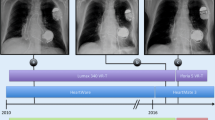Summary
Given the high number of active medical devices implanted and the deliberate installation of security (mostly antitheft, EAS) gates, reports on serious functional impairment of pacemakers and implantable defibrillators by those systems are rare. Clinical and laboratory tests exhibit huge differences between the various antitheft equipments which relate to the operating mode, frequency, flux density and modulation of the magnetic field and result in a 0% up to 96% proportion of interference with rhythm management devices. With the knowledge of frequency dependent interference thresholds of pacemakers, a mathematical and experimental model of magnetic induction allows for calculation of magnetic flux densities which should not be exceeded by EAS systems to be safe. The model shows the left sided, unipolar, malprotected pacemaker programmed to maximum sensitivity to be the worst case scenario. The model gives reason for several standards which have been approved by the relevant committees and are yet to be converted into national law. The model creates a framework which includes upper limits of magnetic flux densities for the EAS producers and a classification of implantable devices from 0 (resistent) up to 2 (susceptible to interference). Implanting centers and following physicians may use this classification to minimize the risk for their patients. Individual advice, however, is mandatory depending on the indication for rhythm management and the different behavior of pacemakers versus ICDs.
Zusammenfassung
Angesichts der Verbreitung aktiver elektronischer Implantate und ubiquitärer Installation von Überwachungs-, zuvorderst Diebstahlsicherungs-(EAS-)Anlagen sind Berichte über ernsthafte Funktionsstörungen von Schrittmachern und Defibrillatoren durch solche Geräte selten. Klinische und Labor-Tests belegen große Unterschiede zwischen den installierten EAS-Systemen, welche in Funktionsprinzip, Signalfrequenz, Feldstärke und -Modulation begründet liegen und damit auch das Störpotenzial gegenüber aktiven Implantaten zwischen 0 und 96% variieren lassen. Die Modellierung magnetischer Induktions- Szenarien erlaubt es, aus der Kenntnis frequenzabhängiger Störschwellen von Schrittmachern die magnetischen Felddichten zurückzurechnen, welche von EAS-Anlagen maximal erzeugt werden dürfen, um Träger von elektronischen Implantaten nicht zu gefährden. Sie erlauben, den linksseitig implantierten, unipolaren Schrittmacher mit hoher Empfindlichkeit und schlecht konzipierter Störprotektion als Konstellation höchsten Risikos zu identifizieren. Sie stellen die Basis für Normungsvorschläge dar, die von den zuständigen Gremien bereits verabschiedet sind und jetzt noch Eingang in nationales Recht finden müssen. Den Felderzeugern sind damit Grenzen gesetzt, welche die Kompatibilität ihrer Anlagen mit normgerechten Implantaten sichern sollen. Implantierender und nachbetreuender Institution hilft die Klassifizierung der Implantate in 0 (angemessen störfest) bis 2 (störempfindlich), das Risiko für ihren Patienten zu minimieren, wobei die Art der Rhythmusstörung und das unterschiedliche Reaktionsmuster von Schrittmachern und Defibrillatoren in individuelle Verhaltensregeln münden müssen.
Similar content being viewed by others
Author information
Authors and Affiliations
Rights and permissions
About this article
Cite this article
Fröhlig, G. Störbeeinflussung aktiver medizinischer Implantate durch elektronische Sicherheitssysteme. Herzschr Elektrophys 15, 55–64 (2004). https://doi.org/10.1007/s00399-004-0409-x
Received:
Accepted:
Issue Date:
DOI: https://doi.org/10.1007/s00399-004-0409-x




